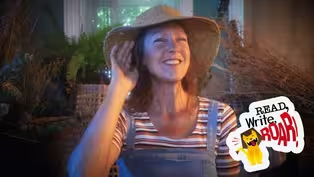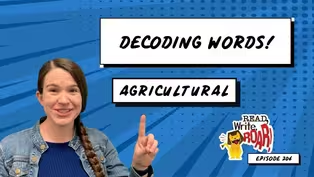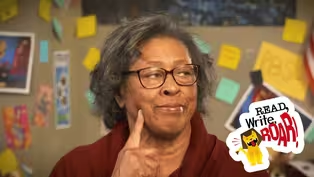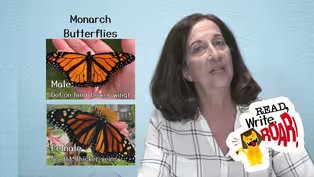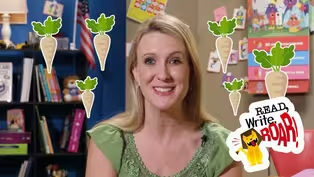Read, Write, ROAR!
Growing Our Food, Then and Now!
Season 1 Episode 1018 | 26m 45sVideo has Closed Captions
Learn all about the life of a farmer and how their work is an essential part of everyone's lives.
On Read, Write, ROAR! Learn about how farmers in Michigan grow some sweet crops.... sugarbeats. Then, learn all about the life of a farmer and how their work is an essential part of everyone's lives. Let's go Read, Write, ROAR!
Problems playing video? | Closed Captioning Feedback
Problems playing video? | Closed Captioning Feedback
Read, Write, ROAR! is a local public television program presented by Detroit PBS
Read, Write, ROAR!
Growing Our Food, Then and Now!
Season 1 Episode 1018 | 26m 45sVideo has Closed Captions
On Read, Write, ROAR! Learn about how farmers in Michigan grow some sweet crops.... sugarbeats. Then, learn all about the life of a farmer and how their work is an essential part of everyone's lives. Let's go Read, Write, ROAR!
Problems playing video? | Closed Captioning Feedback
How to Watch Read, Write, ROAR!
Read, Write, ROAR! is available to stream on pbs.org and the free PBS App, available on iPhone, Apple TV, Android TV, Android smartphones, Amazon Fire TV, Amazon Fire Tablet, Roku, Samsung Smart TV, and Vizio.
Providing Support for PBS.org
Learn Moreabout PBS online sponsorship- On Read, Write, Roar, learn about how farmers in Michigan grow some sweet crops, sugar beets.
Then learn all about the life of a farmer and how their work is an essential part of everyone's lives.
Let's go, Read, Write, Roar.
- [Narrator] This program is made possible in part by the state of Michigan and by and by viewers like you, thank you.
(upbeat music) - It is so nice outside.
I can't help but smile because it's so nice outside with the bright sunshine and the sky filled with fluffy clouds that make me just wanna jump on them.
Hi scholars, I'm Mrs.
Mask, and I just described what it looks like outside with two different sentences, but which one was more interesting to listen to?
Which one made you just wanna drop everything you were doing and run outside to take a walk or ride a bike?
I totally agree.
The second sentence actually included the first sentence in it, but we expanded the sentence or made it bigger by adding more detail.
We used adjectives or describing words like bright, fluffy to bring our sentence to life.
We also added in more nouns like sunshine, sky, and clouds and verbs like smile and jump.
When we expand our sentences with details and clearer language, our writing becomes more interesting to read.
We're going to practice expanding our sentences today by watching a short video clip of a young man who's working on a dairy farm.
We'll start with a short sentence about what we watched and then expand it.
Let's get started.
I could describe this scene by writing the boys in the barn with cows in hay.
While that certainly is true, but what adjectives could we add to this?
How could we describe the boy?
He's wearing jeans and a baseball cap.
How about the cows?
Yep, they were mooing and waving their tails around.
The hay, it actually looked dry and the boys were tossing it around.
What was he tossing the hay around with, a pitchfork.
What was the barn floor covered in, yep, hay.
So let's try to expand this sentence with some adjectives, nouns, and verbs we came up with.
The boys in the barn with cows and hay.
In a barn, the farm boy used a pitchfork to toss the dry hay covering the floor while the cows were mooing and waving their tails.
What adjectives did I add, farm in front of boy, dry to describe the hay.
How about nouns and verbs?
I added in the noun cows along with the verbs toss, mooing, and waving.
That sounds so much more interesting and descriptive.
Let's try another one.
Here, let's watch this clip.
(upbeat music) I could write the boy made his breakfast.
Yes, that tells us what he did, but can we add more detail to give us more information?
What ingredients did we see the boy add to the eggs that were already in the batter, vanilla and cinnamon.
What did he do each time he added an ingredient?
He mixed the batter with the fork.
Once he was done with the batter, what happened next?
The boy covered his bread with the batter and fried each piece of the bread on the griddle.
I can also guess from the ingredients in the batter and the way the boy fried the batter that he made french toast.
So let's try to expand this sentence with some of the details we generated.
The farm boy made his breakfast by mixing a batter with eggs, vanilla, and cinnamon, covering the slices of bread with batter before frying them on the griddle to make french toast.
What did you notice when I expanded the sentence?
Yes, I added some verbs, mixing, covering and frying, which gives a clear description of the boy making his breakfast.
Did you notice that I also added more nouns to expand the original sentence?
Eggs, vanilla, cinnamon, batter, griddle, French toast.
How does that sound?
Did you get a better description of how the boy made his breakfast after I expanded the sentence?
Can you visualize that better now?
When we expand our sentences with detail, it gives our reader more information and makes our writing more interesting to the reader.
Give it a go next time you're putting your pencil to the paper or your fingers to the keyboard.
(upbeat music) - I'm Ms. AP here to help restore your energy.
But before we begin, let's start our warmup.
Today we're gonna do five jumping jacks.
Ready, set, go.
One, two, three, four, five, nice job.
Now that we have warmed up our body, we are ready to exercise.
Today we are going to use our squat jump as we practice basketball jump shots.
Let's stand in our ready position with our feet apart.
If you have a ball to hold, go ahead and hold that ball with both hands.
Otherwise, you can pretend you are holding a ball with both hands.
Next, you'll bend into your squat position, jump up.
As we jump, you are going to push the ball toward the hoop and the shot.
Let's try this together.
Stand tall, holding your ball, bend your knees, jump up and shoot.
Now let's see how many we can do together.
Ready, set, go.
(upbeat music) Good job, give yourselves a big clap clap.
Let's start our cool down.
Take two deep breaths in.
Breathe out, one.
Breathe in, breathe out, two, great job.
- Do you ever find complicated words while you're reading?
I know I do, I'm Mrs. Mora.
Today we'll learn to use word parts like prefixes and suffixes to read unknown words.
Here's a word.
First, let's circle the prefixes.
A prefix is a word part added to the beginning of a word to change its meaning.
Is there a prefix in this word?
This part, agra, isn't a prefix, but it is a different kind of word part.
Agra means farming.
Now let's circle the suffixes.
A suffix is a word part added to the end of a word to change its meaning.
Do you see a suffix?
We see -AL, AL.
Al is often added to nouns to make adjectives that mean of or relating to.
Next, let's mark the vowels in this middle part.
Vowels help us break words into syllables.
Each syllable can have only one vowel sound.
We see U and the R controlled vowel sound, -UR, which says UR.
Since there are two vowel sounds, we'll split this into two syllables.
Let's separate these vowel sounds between the consonants L and T. Let's say the word parts, AGRI-CUL-TUR-AL.
Now, let's say the whole word, agricultural.
Is that a real word, not quite.
Let's try some different letter sounds to make it a real word.
Oh, agricultural, sometimes the T says tu when followed by a U.
Culture sometimes means raising plants or animals.
So agricultural describes farming to raise plants or animals.
Agricultural workers spend long hours caring for crops during the growing season.
If you speak Spanish, words like (speaking foreign language) can help you understand this word.
Here's another word.
First, let's circle the prefixes.
Do you see any prefixes?
There are no prefixes, so let's circle the suffixes.
We see -AL again, AL.
Now let's mark the vowels.
EA will likely make one vowel sound and O will make a second vowel sound.
So we expect to find two syllables.
Let's split these syllables between the vowel team, EA and the S. Let's say the word parts, SEA-SON-AL.
Now let's say the whole word, seasonal.
Is that a real word, not quite.
Let's try different sounds to make this a real word.
Oh, seasonal, the S often says Z after a vowel and the O is making the schwa sound.
Season can mean one of the four seasons: Spring, summer, fall, or winter.
Seasonal describes something relating to a season or one of the seasons.
If you eat seasonal fruits and vegetables, your food is fresh and delicious.
Great work today.
Keep reading and try the strategy the next time you find a challenging word.
(upbeat music) - Do you like sugar, I love how sweet sugar tastes.
I'm Mrs. DeFauw and I'm excited to read and write with you today about a super sweet topic, sugar beets.
Today as we learn about sugar beets, we are going to think about our thinking as we read.
This is called metacognition.
Our purpose for reading today is to paraphrase what we learn.
Paraphrase means to write about what you learn in your own words.
We will also practice inserting direct quotes.
Direct quotes are the author's actual words we want to use in our writing.
When we read, we are learning, so we must use our metacognition.
Ask yourself, does the text make sense?
If the text doesn't make sense, a siren should go off in our heads that says, reread, reread.
You need to stop and use your strategies to help to code and comprehend or understand challenging vocabulary.
I will write a summary using paraphrases or my own words and quotes or the author's exact words.
A summary includes the most important ideas from a text and connects its central ideas in a way that helps me better remember what I read.
Since comprehension requires understanding vocabulary, let's talk about four vocabulary words in this passage.
Harvest, acres, facility, processing.
Remember, we're learning about sugar beets.
In this passage, harvest means to collect the sugar beets from the ground.
An acre is a unit of measurement for land.
Facilities are buildings and processing is following steps to turn sugar beets into sugar.
Now that we know some of the vocabulary, let's read the text.
After reading, let me show you how to do this important work.
First, I learned a lot from reading the source, but because I think some of these words might be challenging for us to read, even with our decoding strategies, I rewritten parts of the text to help us comprehend it more easily.
We need to understand what we are reading if we want to use the content or information in our writing.
Let's read aloud the rewritten text to learn about the Michigan Sugar Company.
I would love for you to read along with me.
The farmers that make up the Michigan Sugar Company plants and harvest sugar beets.
Each year, they grow about 4.5 million tons of sugar beets across 140,000 to 150,000 acres of land.
The sugar beets are processed at factories in Bay City, Caro, Croswell, and Sebewaing and turned into 1.2 billion pounds of sugar.
The Michigan Sugar Company impacts the economy.
At the processing facilities, machines separate sugar from the beets.
The extraction process involves washing, slicing, diffusion, filtration, crystallization, drying and cooling.
The sugar is packaged into bags and shipped to customers.
Michigan Sugar Company is the third largest of eight sugar beet processing companies in the United States.
Michigan is one of 11 states where sugar beets are grown.
To make sure I understand, I will reread this passage and highlight key words and quotes.
Rereading and highlighting texts helps us as readers.
I highlighted in yellow the following key points I want to paraphrase in my summary.
Michigan Sugar Company, sugar beet farmers, 4.5 million tons, 140,000 to 150,000 acres, economy, separate sugar, packaged into bags, customers, third largest company.
I highlighted in green direct quotes I want to use because I don't think I can paraphrase them very well or put them into my own words.
As a reader and a writer, now I need to write about my reading to show what I learned.
I'm going to paraphrase some of the content into my own words.
Also, I'm going to use direct quotes for two of the sentences.
Let's read what I wrote.
The Michigan Sugar Company has sugar beet farmers who grow 4.5 million tons of sugar beets every year across 140,000 to 150,000 acres.
The farmers send the sugar beets to facilities.
The sugar beets are processed at factories in Bay City, Caro, Croswell, and Sebewaing, and turned into 1.2 billion pounds of sugar.
At the factories, sugar beets are separated into sugar.
The extraction process involves washing, slicing, diffusion, filtration, crystallization, drying and cooling.
The farmers are important to Michigan's economy because customers buy the package sugar.
Notice when I use quotation marks, if I am using the author's words exactly, I have to frame those words in quotation marks to show my reader that this is copied text, not paraphrase.
What's the difference between paraphrasing and quoting?
When we paraphrase, we rewrite what we read in our own words.
I like to use a bulleted list of my own notes because if I rewrite while looking at my own notes, I don't copy the text.
When we quote an author, we copy exactly what they wrote and we put those words in quotation marks.
Shout out if the example is a paraphrase or quote.
Right, paraphrase, yes, quote, how do you know?
That's right, there are quotation marks.
When we know more about a topic, we can write a summary about that topic based on what we read and understood using metacognition.
Summaries include paraphrasing and direct quotes.
Writing about our reading helps us learn.
Readers and writers, we worked hard today, just like sugar beet farmers worked very hard to bring sugar to our grocery stores.
(upbeat music) - Hello friends, I'm Miss Audra, and today, we're gonna hang out on the farm.
We're gonna use our imagination and we're gonna think about all the beautiful sounds that we might hear on the farm.
We could think about the cow moo.
We could think about the horse, or there's a chicken or rooster.
We're gonna think about all the different sounds and before we do that, let's take a deep breaths together and you can let it out any way you want today.
Here we go.
Then hold and then blow it out with a moo.
And here we go, one more time, then blow it out, just like the cow today.
So remember, we're gonna make sounds that we might hear on a farm, and don't forget to make a hand movement.
You could use your fingers, your hand, your whole arm, and your whole body if you have enough space.
So on the count of three, I'm gonna listen and then I'm gonna make my own sound too.
You go one, two, three... And I make my sound.
(screeching sound) And one, two, three, pause, nice job.
Think about all the sounds we made today, the cacophony of afar.
So before we say goodbye, let's take our last breath.
Just calm and cleanse our bodies, here we go.
And blow it out any way you want.
Nice job, see you next time.
- Grow big and strong, my lovely milkweed plants.
The monarch butterflies are depending on you to keep their eggs hidden and to provide food for the caterpillars once the eggs hatch.
Hello scholars, I'm Media Literacy Maddie, you're here just in time to help me water the milkweed.
- That milkweed is called the weed for a reason.
Just get rid of it.
- Get rid of it, no way.
Milkweed is the only food source for monarch butterflies who are on the endangered species list.
This means the monarch butterfly is in danger of extinction or dying out.
We need to chat with Ms. Kara who's reading about monarch butterflies and milkweed.
She'll teach us to identify reliable sources and how to verify the expertise of those interviewed.
I'm Ms. Kara, I heard Media Literacy Maddie say something about someone wanting to get rid of her milkweed.
I bet she needs to calm down for a few minutes.
Let's take a look at this article to learn about what monarch butterflies need to survive.
Research articles can be found digitally, in newspapers and magazines.
The article we'll look closely at today is published on the PBS NewsHour website.
Its headline is "Monarch Butterflies Now Classified as Endangered".
The first clue the information is reliable or trusted is that it is written by the Associated Press or AP.
Traditionally, when the AP reports news, it writes with very little bias or opinions.
When a news source doesn't have bias, the goal is to report only facts.
One way to check for reliability of a digital article is to look for a .edu or .org in the URL.
If an article is from a .edu or .org, the article is usually reliable.
Here is an example of an article with a .org ending with good information about monarch butterflies.
This webpage has an EDU ending.
EDU endings are used when an article is published by a college or university.
Carla University published this article.
The writer of this article discusses the monarch butterflies long migration to Mexico and gives us additional reliable information about our topic.
Let's check on Maddie.
This article is about different of milkweed and it's written by the Associated Press.
I'm going to save it and read it later.
Now we need to learn how to check if the people quoted in the article are reliable and trusted sources of information.
Quotes show us exactly what an expert on a topic sets.
One way to check if someone is reliable is to research their background.
I learned Stuart Pimm is an expert in present day extinctions.
Given his background, he's a reliable source on topics like the endangered monarch butterflies.
As an expert, he can confirm that the only food source for monarch butterflies is in fact milkweed.
Scholars, who would you consider as a reliable source of information for an interview about the book collection in your school library?
I hope you understand why we cannot get rid of milkweed.
To keep monarch butterflies from becoming extinct, we need to keep planting milkweed just like the plants you saw me watering earlier.
Today, we learned how to determine if what we are reading is from a reliable source, and if the person who was quoted can be trusted.
Now, use your knowledge to verify your sources when you are doing your own research.
- Thank you so much for watching.
For activity guides, videos, lessons, and so much more, be sure to visit our website, MichiganLearning.org.
And don't forget to read, write, roar.
(upbeat music) - [Narrator] This program is made possible in part by, the state of Michigan and by and by viewers like you, thank you.
(upbeat music)
Create a Farm Animal Soundscape | Ms. Audra | Read, Write, ROAR!
Video has Closed Captions
Clip: S1 Ep1018 | 2m 13s | Think about the sounds cows, horses, chickens, and roosters make. (2m 13s)
Decoding Words! AGRICULTURAL | Prefixes, Suffixes, and Root Words for Multisyllabic Words
Video has Closed Captions
Clip: S1 Ep1018 | 4m 37s | Mrs. Mora teaches us how to use prefixes and suffixes to decode words related to farming. (4m 37s)
Expanding Sentences: A Day on the Farm | LaDonna Mask | Read, Write, ROAR!
Video has Closed Captions
Clip: S1 Ep1018 | 6m 17s | Learn how to make your sentences more descriptive and engaging with Mrs. Mask! (6m 17s)
How to Identify Reliable Sources | Ms. Kara | Read, Write, ROAR!
Video has Closed Captions
Clip: S1 Ep1018 | 4m 25s | Discover how to identify credible sources in research. (4m 25s)
How to Paraphrase | Sweet Sugarbeets | Mrs. DeFauw | Read, Write, ROAR!
Video has Closed Captions
Clip: S1 Ep1018 | 6m 41s | Learn how to paraphrase information and use direct quotes. (6m 41s)
Providing Support for PBS.org
Learn Moreabout PBS online sponsorship

- Home and How To

Hit the road in a classic car for a tour through Great Britain with two antiques experts.












Support for PBS provided by:
Read, Write, ROAR! is a local public television program presented by Detroit PBS
